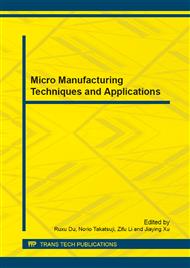p.1
p.13
p.23
p.39
p.45
p.53
p.63
p.69
Tissue Cutting Mechanics and Applications for Needle Core Biopsy and Guidance
Abstract:
Needle is one of the most common features in medical devices. A better understanding of needle tip geometry can lead to the creation of an optimized needle tip geometry which would greatly benefit the procedure of biopsy or insertion guidance. This study reviews the recent researches on needle cutting edge with high inclination angle, and applications in needle core biopsy and insertion guidance. The mathematical models of the inclination and rake angles for the needle with lancet point and enhanced cutting edge needles are developed. To improve the biopsy length, a novel approach to use the enhanced cutting edge needle to acquire the tissue sample is studied and the concept is experimentally validated. To reduce needle deflection and increase insertion accuracy, the effects of grid constraints, needle material, and insertion speed are analyzed. The knowledge gained from this study can be used to better understand needle tissue cutting mechanics and integrate these technologies for more efficient needle biopsy and accurate insertion guidance procedures.
Info:
Periodical:
Pages:
13-22
Citation:
Online since:
February 2013
Keywords:
Price:
Сopyright:
© 2013 Trans Tech Publications Ltd. All Rights Reserved
Share:
Citation:


